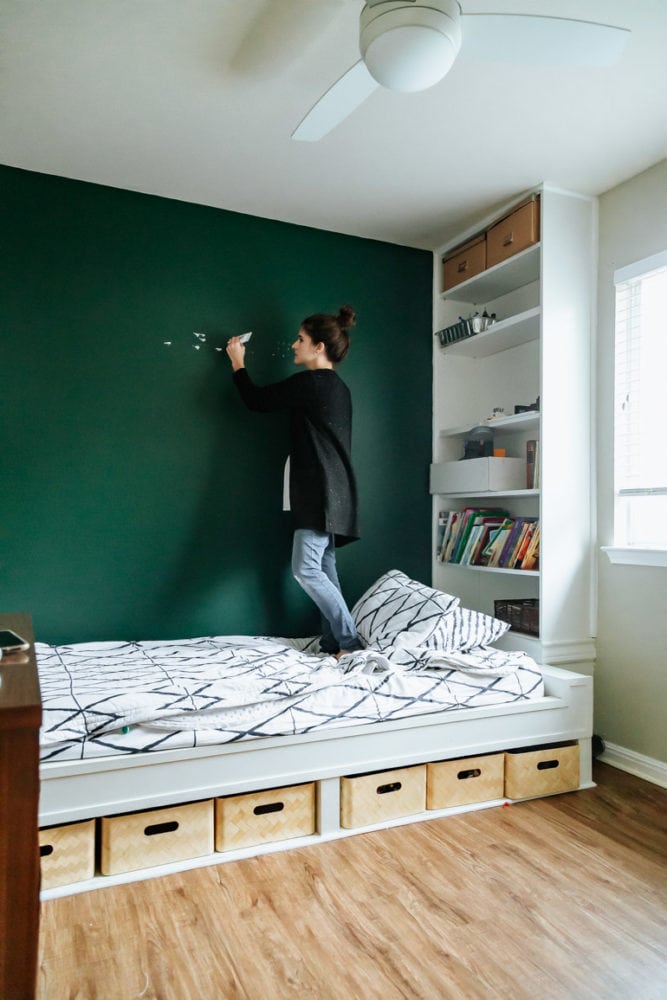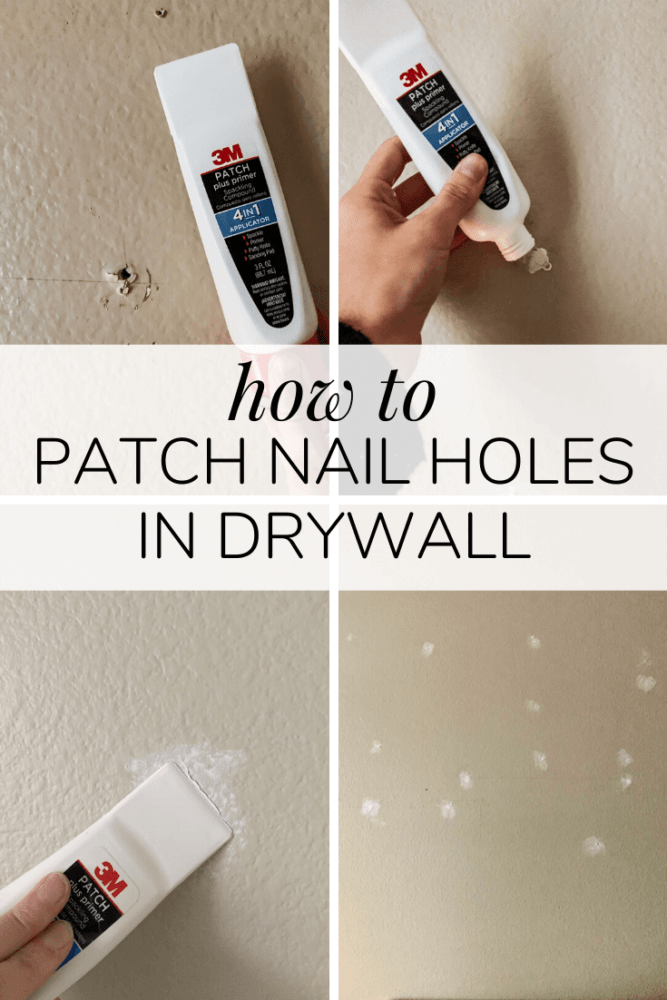How to Patch Nail & Screw Holes In Your Walls
Have some holes in your walls from hanging pictures or other things on the wall? Today I’m going to walk you through how to patch nail, screw, and anchor holes in your drywall (and other wall types!).
One of the little, annoying things about getting ready to move is all of the tiny tasks that you ignore on a day-to-day basis that you really need to take care of for the new owners. Things like scrubbing the baseboards (who has time for that anyways?), cleaning the oven (so much work!), or patching all of the tiny holes in your walls.
Maybe you’re not moving – maybe you just want to change up the art on your walls and when you take down your old gallery wall you’re left with a wall that looks more like it’s been used as a bulletin board.
Patching nail holes can be one of those projects that people put off for forever and ever because they’re intimidated or it just seems like too much work – well, I’m here today to show you that it’s not too much work and it’s not that difficult. It’s affordable, easy, and will be so worth the effort – promise!

How to patch nail holes in drywall
While it might feel intimidating at first, patching nail holes in drywall is actually one of the simplest projects around.
My number one recommendation is to start by grabbing this 3M 4-in-1 Patch Plus Primer. It will make everything so incredibly easy and you’ll be left wondering why in the world you didn’t do this sooner.

Patching small Drywall holes:
- Start by removing the nail or screw from the wall (and be sure to remove the anchor as well if there is one).
- Use the cap of the 4-in-1 Patch Plus Primer to (very) lightly sand down the wall to remove any paint or drywall flakes.
- Squeeze a bit of the Patch Plus Primer into the hole – you want it to completely fill the hole and overflow just a little.
- Use the back end of the Patch Plus Primer tube to press the spackle into the hole and scrape off all of the excess. You’ll want to apply a little bit of pressure here to make sure you aren’t left with a ton of extra spackle.
- Allow it to dry for about 30 minutes.
- Come back with the lid of the spackle tube and lightly sand so that the patch is smooth with the rest of the wall.
- Paint over the patch with the wall color!
That’s it!
There are a few frequently asked questions about this, though, so let’s address those.
Is it hard to make sure the paint matches?
It kind of depends on several factors. If the paint has been there more than a year or so and the sunlight hits it often, it may be slightly faded and not match exactly. You can play around with the tinting of the paint if you need to!
You’ll also want to make sure that you fully stir your paint and if you have to buy more paint to buy the same sheen.
If you don’t have extra paint lying around, my recommendation is to head back to the store and just grab a sample size of your wall color (they’ll do whatever sheen you need, even in the sample sizes). Then, you can keep it on hand for any future painting touch-ups too!
How does this work on texture walls? Is it visible?
If you have textured walls (like we do) it’s always harder to patch holes and make them invisible. I find that as long as you get the paint matching correct, the nail holes generally disappear for the most part, even with texture on the walls. However, some walls are more heavily textured and it’s almost impossible to hide it.
If you need to repair the texture after applying the patch, you can just grab one of these cans of spray texture and (lightly!) apply it to match the existing texture. It can be tricky to get it right, just remember it’s an art, not a science.
Can’t I just use toothpaste to patch the walls?
Nooooo! This is a suggestion you’ll see often as a simple “life hack” but this is not a good long-term solution. Toothpaste isn’t meant for this kind of application (obviously), so even once it dries, it can shrink and crack, leaving you with an unsightly wall.
I promise, the 4-in-1 Patch is just as easy to use as toothpaste would be. Just say no to the toothpaste patch.
Patching Nail holes in plaster walls (& Other types!)
What if you don’t have drywall? When I shared that I was doing this over on my Instagram stories, the questions came pouring in about other types of walls. Here’s a quick rundown of a few of the more common wall types I got questions about.
plaster walls
Plaster walls should be no different than drywall when patching small nail holes. Simply lightly sand the area to remove any loose bits, then fill with the spackle just as you would with drywall!
Brick walls
When patching holes in brick walls, the best method is to mix up some mortar and patch the hole with that. If you want to be sure that the spot blends in well, you can get an extra brick that matches the color of your existing brick, then crush it up and blend with the mortar to dye it to match. Just use a putty knife to spread the mortar into the hole and allow it to dry.
For a simpler method, silicone caulk should also work well to patch nail and screw holes in brick walls, though it might not blend as well if your walls are unpainted.
Paneled Walls
If you’ve got paneling on your walls (shiplap, bead board paneling, or anything else along those lines), patching nail and screw holes is still really simple.
Grab a wood filler that fits the finish on your wall. Something basic like this should work if you plan on painting it, but if the wall is stained you’ll need a wood filler that can handle stain.
Lightly sand the area, then use a putty knife to spread the wood filler into the hole (the best method is to swipe it in one direction over the hole to apply it, then swipe in the opposite direction to remove the excess). Allow it to dry, lightly sand, and apply a second coat before finishing.
Patching nail holes is one of those projects that you might put off for a long time, but I promise that once you get around to doing it, you’ll be shocked at how quick and easy it is to make the walls feel like new!
For more detailed behind-the-scenes on how to do simple projects like this, be sure you’re following me on Instagram stories so you don’t miss a thing!

Where do I order a glass insert to modify my front door like you did? 🙂
You can read more about it right here!